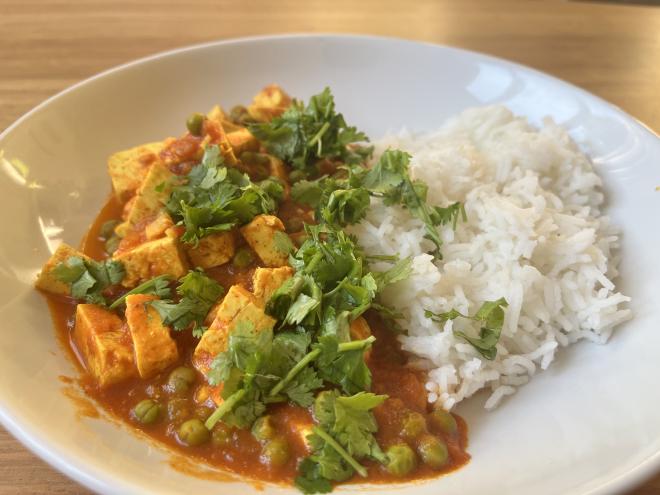Tofu Matar: Curry with Tomatoes, Tofu and Peas
Table of Contents
Jump to Recipe
Jump to Carbon Footprint
I was going to make a curry with tomatoes, paneer and peas (matar paneer) - but it’s been weeks since I’ve been able to find paneer in the local supermarket. So, change of plans, tofu to the rescue. 🤷
Natural tofu has very little flavour, but if you marinate it beforehand (ideally overnight) it will gain some flavour. You can get creative with the marinade, of course: I find that Indian spices and the salty note of soy sauce work well together, but of course you can adapt this and use cardamom, for example. If you’re in a hurry, you can also use tofu with its own flavour - you can often find smoked or turmeric-flavoured tofu in the shops.
Apart from preparing the tofu, the curry is a quick story. At first glance, pureeing may seem a little unnecessary, but it helps the ingredients and flavours come together better. Overall, don’t skimp on spices in Indian curries: If you think you’ve had enough, just add a pinch more…
The recipe is loosely based on the Punjabi Matar Paneer from “German Abendbrot”.

Recipe #
Tofu matar - curry with tofu and peas in tomato sauce
40 minutes
2 portions
Ingredients #
For the tofu
- 200 g tofu
- 1 tablespoon oil
- 2 tablespoons soy sauce
- 1/2 teaspoon turmeric
- 1/2 teaspoon paprika
- 1/2 teaspoon chilli powder
For the curry
- 1 onion
- 2 cloves of garlic
- 20 g ginger
- 2+2 tablespoons oil
- 1 teaspoon cumin / cumin seeds
- 300 g ticanned tomatoes (about 3/4 of a can)
- 1/2 teaspoon turmeric
- 1 teaspoon chilli powder
- 1 teaspoon coriander
- 150 g peas
- 1 teaspoon garam masala
- 2 teaspoons salt
- 5 g fresh coriander
- as a side dish: 120 g rice
Directions #
- Dice the tofu and marinate in a covered dish with oil, soy sauce and spices for at least 2 hours, preferably overnight.
- Peel and chop the onion, garlic and ginger.
- Heat the oil in a small pan, add the cumin and fry for about 1 minute.
- Add the diced onion, garlic and ginger to the pan and fry over a medium heat until the onion is translucent. Pour in the tinned tomatoes and reduce briefly. Turn off the heat and purée with a hand blender.
- Cook the rice: Wash the rice and cook with double the amount of water and a little salt for about a quarter of an hour until the water is absorbed.
- Heat the oil in a large pan and sauté the turmeric, chilli powder and coriander. Add the tomato, onion, garlic and ginger mixture and bring to the boil over a medium heat. Add the peas and marinated tofu and simmer for a further 5 minutes. Season to taste with garam masala and salt.
- Wash and chop the coriander. Serve the rice with the curry and coriander.
Carbon Footprint #
In total, two portions of tofu matar have an estimated carbon footprint of 1603 g.
This ranks it number 30 out of 57 recipes published on the blog so far in terms of estimated carbon footprint.
The carbon footprint of the recipe is therefore slightly higher than the average of the other recipes here on the blog: At least 50% of the recipes cause less emissions, but it is not yet in the worst third of the recipes. 🤨Compared to other curries, Tofu Matar is also in the middle: it has a worse greenhouse gas balance than Lime Dal (1003 g, -37%), but produces fewer emissions than Palak Paneer (2163 g, +35%).
When it comes to the individual ingredients, the rice stands out: Rice is typically grown on rice terraces that are periodically submerged in water. This causes the soil to decompose, releasing methane - and unfortunately methane has a relatively strong impact on the climate (source). Although there have been attempts to grow rice more sustainably and release less methane, these are mainly experimental and cover only a fraction of the area under cultivation (source 1, source 2).
| ingredient | carbon footprint per kg | carbon footprint (in g) for 2 servings | % of ingredients | % of CO2 emissions |
|---|---|---|---|---|
| Tofu | 1.0 | 200 | 20% | 12% |
| Oil | 3.2 | 32 | 1% | 2% |
| Soy sauce | 1.2 | 24 | 2% | 1% |
| Turmeric | 0.5 | 1 | 0% | 0% |
| Paprika powder | 1.1 | 2 | 0% | 0% |
| Chili powder | 1.1 | 2 | 0% | 0% |
| Onion | 0.2 | 16 | 8% | 1% |
| Garlic | 0.5 | 3 | 1% | 0% |
| Ginger | 0.5 | 9 | 2% | 1% |
| Oil | 3.2 | 128 | 4% | 8% |
| Cumin | 1.1 | 5 | 0% | 0% |
| Canned tomatoes | 1.8 | 540 | 31% | 34% |
| Turmeric | 1.1 | 2 | 0% | 0% |
| Coriander | 1.1 | 5 | 0% | 0% |
| Peas | 1.2 | 180 | 15% | 11% |
| Garam masala | 0.5 | 2 | 0% | 0% |
| Salt | 0.7 | 4 | 1% | 0% |
| Coriander | 1.1 | 6 | 1% | 0% |
| rice | 3.1 | 372 | 12% | 23% |
| Cooking curry #1 | 20 | 1% | ||
| Cooking curry #2 | 26 | 2% | ||
| Cooking rice | 25 | 2% |


